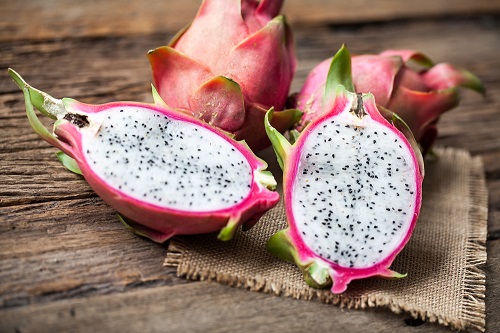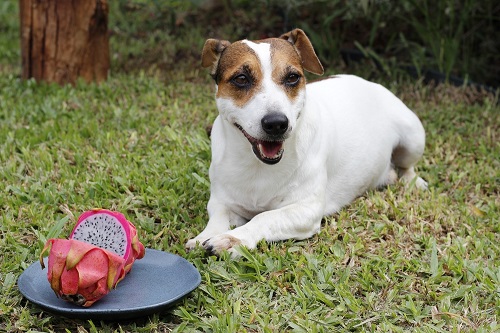Can Dogs Eat Dragon Fruit? Can you feed it to them without worrying on a daily basis? Let’s have a look in detail.

If your pooch loves eating fruits, then you must have thought – Can Dogs Eat Dragon Fruit? If you have, then keep reading to get the answer!
What is Dragon Fruit?

Dragon fruit, also known as pitaya or pitahaya, is a tropical fruit that comes from the climbing cacti of the genus Hylocereus and Selenicereus. It is native to Central America but is now widely grown and exported around the world, including in Southeast Asia and Australia.
Dragon fruit has a unique appearance, with bright red or pink leathery skin covered in greenish scales or spikes. The flesh inside can be white or pink, dotted with small black seeds, and has a mild, sweet flavor that is often compared to a combination of kiwi and pear.
Can Dogs Eat Dragon Fruit?
So, Can Dogs Eat Dragon Fruit? Yes, they can in moderation. Additionally, when giving your dog dragon fruit, make sure to remove the skin and seeds, as they can be difficult for dogs to digest and may pose a choking hazard.
Is Dragon Fruit Safe for Dogs?
Dragon fruit is not known to be toxic to dogs, and it can provide some nutritional benefits, such as vitamins and fiber. Some dogs may be more sensitive to certain foods and may experience digestive upset or other adverse effects after consuming dragon fruit.
Health Benefits of Dragon Fruit for Dogs

Dragon fruit can provide some health benefits for dogs when consumed in moderation. Here are some potential health benefits of dragon fruit for dogs:
- Rich in Nutrients: Dragon fruit is a good source of vitamins and minerals, including vitamin C, vitamin B6, iron, calcium, and magnesium. These nutrients can help support your dog’s overall health and well-being.
- Antioxidant Properties: Dragon fruit contains antioxidants, which can help protect your dog’s cells from damage caused by free radicals. This may help to reduce the risk of chronic diseases and improve their immune system.
- Digestive Health: Dragon fruit is high in fiber, which can help support your dog’s digestive health and prevent constipation.
- Hydration: Dragon fruit has a high water content, which can help keep your dog hydrated and prevent dehydration, especially in hot weather.
- Low-Calorie Treat: Dragon fruit is low in calories, making it a great option for dogs who need to maintain a healthy weight. It can be used as a healthy treat to reward good behavior.
A Few Health Concerns of Dragon Fruit
While dragon fruit is generally considered safe for dogs to eat in moderation, there are some health concerns to keep in mind:
- High Sugar Content: Dragon fruit is relatively high in sugar, which can lead to weight gain and other health issues in dogs if consumed in excess. It’s important to give dragon fruit to your dog in small amounts as an occasional treat, rather than as a regular part of their diet.
- Digestive Issues: Some dogs may experience digestive issues, such as diarrhea or vomiting, after consuming dragon fruit, particularly if they eat too much or are sensitive to certain foods. To avoid digestive upset, introduce dragon fruit gradually into your dog’s diet and monitor their reaction.
- Choking Hazard: The seeds in dragon fruit can be difficult for dogs to digest and may pose a choking hazard. Be sure to remove the seeds and skin before giving dragon fruit to your dog.
- Allergic Reactions: Some dogs may be allergic to dragon fruit, so it’s important to monitor your dog for signs of an allergic reaction, such as itching, hives, or difficulty breathing, after giving them dragon fruit.
How to Feed Dragon Fruit to Dogs?
To safely give dragon fruit to your dog, follow these guidelines:
- Introduce dragon fruit gradually: Start with a small amount of dragon fruit and observe how your dog reacts. If there are no adverse reactions, you can gradually increase the amount.
- Remove the skin and seeds: Remove the skin and seeds from the dragon fruit before feeding them to your dog. The skin and seeds can be difficult for dogs to digest and may pose a choking hazard.
- Cut the fruit into small pieces: Cut the dragon fruit into small, bite-sized pieces to make it easier for your dog to chew and swallow.
- Limit the amount of dragon fruit: Dragon fruit is high in sugar and should be given to your dog in moderation as an occasional treat.
- Monitor your dog’s reaction: After giving your dog dragon fruit, monitor them for any adverse reactions, such as vomiting or diarrhea.
- Consult with your veterinarian: If you have any concerns or questions about giving dragon fruit to your dog, consult with your veterinarian.
By following these guidelines, you can safely give your dog dragon fruit as an occasional treat.
How Much Dragon Fruit Should You Feed Your Dog?
The amount of dragon fruit you can feed your dog depends on its size and dietary needs. As a general rule, you should start with a small amount of dragon fruit and observe how your dog reacts to it. If they have no adverse reactions, you can gradually increase the amount up to a maximum of 10% of their daily food intake.
Quick Takeaways
So, Can Dogs Eat Dragon Fruit? While it’s generally safe for dogs to eat dragon fruit in moderation, it’s important to remember that it shouldn’t be a regular part of their diet.
Although dragon fruit offers many potential health benefits, feeding too much can cause health problems for your furry friend. It’s always best to introduce new foods gradually and in small amounts, monitoring your dog’s reaction and consulting with your veterinarian if necessary.
